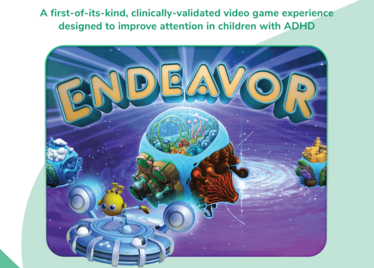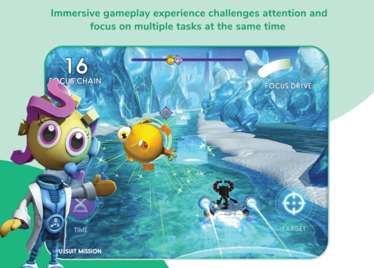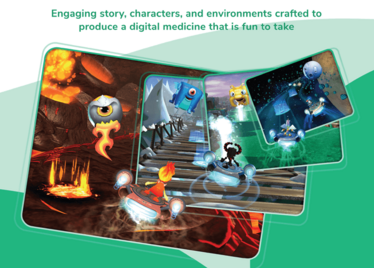The Story Behind Akili Interactive’s FDA-Approved Video Game
How Akili won FDA approval for EndeavorRx – the first “game-based digital therapeutic” for children with ADHD
In June 2020, the FDA granted marketing authorization to EndeavorRx for children aged 8 to 12 years old with ADHD. New therapeutics are approved by the FDA all the time, but this one broke the mould. Rather than popping pills, patients race around alien worlds saving lifeforms from extinction…
But how can a video game ever work as well as a drug treatment that chemically or biologically elicits a therapeutic effect? First, the video game is just the way the medicine is delivered, like a capsule or syringe delivering a pharmaceutical API. Underneath the game are patented stimuli and algorithms designed to target the areas of the brain that play a role in attention function.
The game isn’t intended to be a stand-alone therapeutic – and the company has stressed that it’s not a substitute for a child’s medication. But Akili Interactive, the company behind the innovation, has delivered compelling evidence that shows how EndeavorRx improves attention function in children with ADHD, as measured by the Test of Variables of Attention (an FDA-cleared objective test of attention), as well as other assessments such as reports from parents and physicians. Studies were conducted in more than 600 children – and, perhaps unsurprisingly, there were no serious side effects (although adverse events included frustration, headache, dizziness, emotional reaction, and aggression) (1).
Video games don’t have the best reputation in certain circles. For as long as video games have been around, there have been concerns about how they impact children. But with video games continuing to increase in popularity, some researchers have started to focus on the positive side. Studies have emerged showing how video games can improve mental health; for example, a paper published in 2021 by researchers at the UK’s University of Oxford claimed that video gameplay was positively correlated with mental health (2).
Also in 2021, scientists from UC San Francisco’s Neuroscape translational neuroscience center reported that they had developed a virtual reality video game that could potentially help improve memory in healthy, older adults (3).
But the approval of EndeavorRx really takes the game to the next level. Here, I ask Anil Jina, Chief Medical Officer at Akili Interactive, how the approach works and why gaming should not be dismissed as a gimmick when it comes to neurological disorders.

What’s the story behind Akili Interactive?
It started when our co-founders, Adam Gazzaley (Chief Scientific Officer), Matt Omernick (Chief Creative Officer), and Eddie Martucci (CEO) found themselves thinking about the same problem – but from different angles. On the science side, Adam was (and still is) a neurologist with UC San Francisco. He heads up the university’s translational neuroscience center, Neuroscape, and has written books around the cognition crisis. Our cognition is being bombarded and declining due to various intrinsic and extrinsic reasons. Adam wanted to find ways not only to assess this but also to improve cognition. Cognitive training does exist, but the tasks are usually delivered in a human way, on a one-to-one basis, and you cannot deliver multiple tasks simultaneously. Adam wanted to find ways to deliver different cognitive tasks together, but the only way to do this is to make it digital.
Adam then met Matt Omernick, who comes from the gaming world and has experience in big gaming houses on the west coast, including EA and Lucas. Matt explained that there was a trend in the tech sector exploring gaming for good, as well as interest in using video games to help improve generic cognition and attention. Eddie Martucci is a biologist by training and comes from the venture capitalist side in Boston; after seeing the research, he became very interested in the concept. And that’s how the three of them linked up – and how Akili Interactive began.
To an extent, cognitive function is practiced almost daily. For example, I’m having to concentrate on this video call with you right now. I have to ignore my wife, who is on a Zoom call in the other room, and I have to ignore all of the things on my desk. There may be other things in the home that I have to ignore too. A more intense example? Consider playing a sport like soccer. You need to think about the ball, think about the other players, think about movement and space, think about how you handle the ball, how you position your hands and feet – all while abiding by the rules of the game.
In 2013, Adam co-authored a paper in Nature, which made the cover and distilled a lot of research about cognition, multitasking, and the potential of using a custom-made video game to enable cognitive training and improve multitasking performance (4). Ultimately, the paper showed that it was possible to formally embed cognitive tasks from the ground up in a video game. A custom designed game was used to assess the cognitive performance of players – and it showed a linear, age-related decline from 20 to 79 years of age. We all know that cognition declines with age – which is disappointing for everyone – but the game specifically showed that it was a steady decline.
The paper also showed that when the 60 plus age group was “treated” using a specially designed game for a month (about a half an hour a day; five days a week), their cognition improved and, crucially, was sustained for six months. This provides evidence of a neuroplastic effect – something happens in the brain cells and pathways that enables the cognitive training to embed itself, rather than just disappear. All of this is very different from drug development, where you have a molecule and receptor that bind together, exerting an effect that lasts until the drug is metabolized or actively released.

The researchers also looked at EEG data and saw that the brain activity promoted by gaming was in the prefrontal cortex – the location of the attention networks. After a month of playing, older adults showed a different picture of neurological activity compared with before playing. Notably, the activity was similar to that in the baseline 20–40 year old group. Players who received all the tasks at once – forcing them to multitask rather than playing different subsets of the game – saw the largest improvement.
All of this research fed into Akili’s strategy. Gaming and medical specialists were hired to work together on the task of developing a game as a medical device. Here, I’d like to note that the development of the game followed the same rigorous development as a drug in terms of clinical trials with clinical endpoints.
In June of 2020, we obtained regulatory clearance from the FDA for EndeavorRx to be prescribed for children aged 8 to 12 years old with primarily inattentive or combined-type ADHD who have demonstrated an attention issue (5). This isn’t meant to replace ADHD drugs that are working for some kids, but it’s a great new option that parents can turn to as part of their child’s treatment.
Did you face any scepticism at the outset?
There was a lot of scepticism about using gaming in such a manner, but we were not deterred. Ultimately, no one fully understands how the brain works – we’re only just scratching the surface of a lot of the functionality. Given our collective lack of knowledge in this area, it could be considered naïve to assume that a different approach is not viable. And to be blunt, if existing drug therapies are so good, why do we still have cognitive decline and so many neurological issues?
In my experience, there is scepticism or uncertainty around cognition in general. I am a trained physician, so I know that those studying medicine learn very little about the functional aspects of cognition – this is the realm of psychologists, cognitive scientists, and behavioral therapists. But when I worked as an anaesthetist, I often saw people coming out of anaesthesia with cognitive dysfunction – and it would commonly affect older people for longer. When I worked in the neuroscience space on schizophrenia, bipolar disorder, and depression, there was certainly an awareness of cognitive dysfunction – but because no treatment existed it was not a focus.
But the world is changing – and we’re now seeing more acceptance of the cognitive deficits presented in many disorders. “Brain fog” is a term frequently used by patients to describe symptoms of various disorders – including those who have recovered from COVID-19. Here, perhaps some type of inflammatory or microvascular mechanism is causing cognitive function to be depleted. For most physicians, this brain fog or decline in cognitive performance becomes almost irrelevant compared with the immense physical impact of the original symptoms/disease. However, if many people in the general population are saying, “I’m not sick anymore, but I can’t work or look after my children or go grocery shopping,” the impact would be huge. We should not ignore those cases where an improvement in cognition lags behind physical improvement.
There is only so much that doctors can do, but I hope new approaches – for example, home-based cognitive training (potentially using gaming) that adapts to a patient’s changing needs – will ultimately be able to help.
What makes gaming such an intriguing approach for cognitive training?
In short, it’s truly new. I was super excited to join the company just over three years ago because it wasn’t simply digitalizing an existing medical therapy (there are a lot of digital therapeutics out there that are digitizing traditional cognitive behavior therapy, standardizing and simplifying to improve access. Akili Interactive has created a new therapy that can only be delivered by this game. And nothing else like it exists on the planet!

The game incorporates multiple tasks that deliberately hit different aspects of attention including processing speed, sustained attention, divided attention, conflict resolution, focus, and interference processing. Cognitive scientists or therapists can measure these with different tests and offer certain therapies but they can’t give you something that targets all of these at once. A game can. And it does this in a fun and engaging way that is also adaptive.
Why choose ADHD as your first target?
We looked at several diseases and disorders – and there are a number of areas where we believe our approach could have benefits; however, we had to keep in mind the scepticism we would undoubtedly encounter. We felt it was important to focus on an area where people might intuit that a game-based approach could work. We didn’t want huge leaps of faith – we needed people to think, “Okay – yeah – that actually makes sense.”
After much discussion, we settled on children with ADHD for two key reasons. First, children typically love games! And second, our game had been designed to focus on the attention networks of cognition, rather than something like memory. Attention is clearly a critical part of ADHD – and, importantly, established scales and clinical outcomes for ADHD already exist. In other words, if the game could boost the attention network in patients, we should be able to measure the improvement on the scale. In other disorders, such as schizophrenia, there are fewer scales that measure cognition, so it’s more difficult to prove the benefits of therapy.
We met with the FDA to explain our approach and we also shared results from a pilot study. We discussed what could be improved and we agreed on endpoints that made sense from both an ADHD perspective and a regulatory perspective. We did the study and the results were positive. With data from five clinical studies in more than 600 kids with ADHD, the FDA approved the game in June 2020 as a class II medical device. It was such an amazing accomplishment. Sadly, we didn’t get to have a celebration party because of pandemic lockdowns!
What is the gameplay like?
The meta story for the game is that the player is a space cadet who travels from world to world to participate in missions. Each world has a different landscape and there are certain tasks to accomplish. Often, the planet is collapsing and the player needs to save different alien creatures from extinction. The player must follow a meandering path – which could be a stream, lava, a road, or even just space, depending on the world – through the level and capture creatures to put in their space farm.
Ultimately, all of this world building is just a mask to disguise a set of challenging cognitive tasks…
The player’s avatar rides a hover platform through the level. The road meanders randomly and the player steers by tilting their phone or iPad left and right to avoid hitting the edges. Depending on the level, there may be gates to pass through (like in ski racing) or barriers to avoid. This cognitive navigation task requires sustained, selective attention.
Gameplay also incorporates conflict resolution inhibition. As well as steering and avoiding or hitting certain obstacles, the player is tasked with capturing aliens. At the start of the level, players are shown the different alien creatures that inhabit the world – usually three, but it can increase on the harder levels. They are told to capture just one of them – perhaps the blue one, the spiky one, or whatever. As the player is steering through the level, alien creatures jump at the player from the side of the screen. The player must tap when they see the correct alien and suppress their urge to tap when they see the others. The game also draws on working memory requirements as the player needs to remember the type of alien they need to capture.
Because a multitude of cognitive tasks targeting the attention network come at the player simultaneously, the player cannot just focus on one aspect – steering or capturing aliens – they must divide their attention between both.
The team has also incorporated other aspects you would expect from a video game. For example, completing levels and tasks earns in-game currency that can be spent on different costumes. Players can also customize their spaceship and unlock additional missions.
Perhaps most importantly, the game constantly adapts and is personalized for each patient in terms of the speed, frequency of the gates and obstacles, and the targets coming at the player. This cognitive load is balanced in a staircase fashion on a second by second basis. If the level of cognitive stress on the attention is too much and the player makes too many mistakes, such as hitting the edges or catching the wrong alien, the speed is reduced. If they are steering really well, avoiding obstacles or hitting the gates correctly, and making the correct no/go decisions on the aliens, the game speeds up.

This is a big difference between EndeavorRx and most standard video games. In a regular game, all players start at level one and require the same level of aptitude to reach level two, level three, and so on. Because EndeavorRx adapts to the player’s cognitive function, “level one” will vary from player to player. Some children with autism and ADHD may be at the lower end of the functional spectrum, but others can be highly functioning. Because the game adapts to ability, all kids can progress to levels that are relevant to them. Once the baseline is set, the game follows an algorithm that tries to challenge and push the player’s cognitive function enough to stress – but not overstress. In other words, every child has a meaningful experience, regardless of their cognitive ability.
This “baselining” happens at the beginning of the game, but it also continues throughout the child’s gameplay based on data that is collected second by second. The game tries to keep the player at the right level and will adapt if they start to find it too easy or too difficult.
Kids will be kids, and so a few have tried to “game” the game – purposely performing badly at the beginning so that they can start on an easy level and do better. But, like all good game designers, we already anticipated that behaviour, and EndeavorRx quickly adapts to their true ability!
Could the game be used in other neurological diseases – such as Alzheimer’s disease?
In every patient population we have studied, we have seen cognitive improvements. The big challenge lies in answering two questions: Would the improvement be clinically meaningful? And would it last? I cannot answer these big questions right now because the studies haven’t yet been conducted. My gut feeling is that it’s worth trying.
Doctors keep asking us about Alzheimer’s, and I think it would be great for us to expand into other areas. The indications we’ve studied the most are ADHD, multiple sclerosis, autism and depression – and we’re starting to publish more scientific and medical data so that others can read and interrogate our findings (6). But I’d like to reiterate that the studies we do are rigorously designed to answer clinical questions – and they are just as robust as the type of studies I would have done in my previous roles at Pfizer, Sanofi, and Shire.
What are your thoughts on the “over-the-counter” equivalent in the world of digital therapeutics?
In gaming, this is known as the wellness space. And there are many companies who have developed consumer “brain-training” games, but they can’t make claims from a disease perspective or they’ll run afoul of advertising standards and regulatory bodies. For example, such companies cannot say, “This game can improve your cognition, which is important for diseases, such as Alzheimer’s.” When targeting the general wellness market, you can only talk about common or general health.

Interestingly, there are companies in the wellness space who, perhaps after seeing what we have done, are trying to develop a more regulated version of their product. Equally, there may be the potential to do the reverse too. Personally, I’m glad we’ve done the hard part first!
The great thing about games is the high safety and minimum side effects. Yes, there are still side effects, but things like frustration and headache – not in the same league as some drugs. From that perspective, games are well suited to be used as wellness products.
How have traditional pharma companies reacted to your work?
Some have recognized the potential of the space. Shire, for example, which does a lot of work in ADHD, was an early investor. We’ve also had interactions with pharma companies working in other disease areas.
But some pharma companies are very conservative and see products like ours as fitting in very differently to standard therapeutics. At a consumer electronics show a few years ago, our CEO stated that we are happy to talk with pharma companies but made it clear that we are not the toy in the Happy Meal. A great analogy! His point being that pharma companies make a lot of money on drugs and are always looking for other offerings that could help better position those drugs. We want our product to have the focus and respect that it deserves. We don’t want to be a side giveaway to promote greater use of a company’s drug.
Healthcare is now evolving beyond traditional providers, pharma companies, and device manufacturers. The likes of Amazon and Google have an interest in health too. I know one thing: this market is going to change. In the future, I hope – or even expect – to see a greater understanding of the scientific rigor behind products like ours.
Essential last question: Do your employees play the game for fun?
When the game was in development, employees across the company were involved in “testing” But now that we have FDA approval, the game is classified as a medical device and is only available by prescription. If we were focused on diabetes, employees could not try out the insulin! In short, we have put restrictions in place.
- H Kollins, D DeLoss, E Cañadas, J Lutz, R Findling, R Keefe, et al., The Lancet, e168-e178 (2020).
- N Johannes, M Vuorre, AK Przybyski, Royal Society Open Science, 8 (2021).
- PE Wais et al., Scientific Reports, 11 (2021).
- JA Anguera et al., Nature, 501, 97-101 (2013).
- FDA (2021). Available at: https://bit.ly/34jjYRb
- Akili Interactive (2021). Available at: https://bit.ly/3KZUw43

Making great scientific magazines isn’t just about delivering knowledge and high quality content; it’s also about packaging these in the right words to ensure that someone is truly inspired by a topic. My passion is ensuring that our authors’ expertise is presented as a seamless and enjoyable reading experience, whether in print, in digital or on social media. I’ve spent fourteen years writing and editing features for scientific and manufacturing publications, and in making this content engaging and accessible without sacrificing its scientific integrity. There is nothing better than a magazine with great content that feels great to read.



















